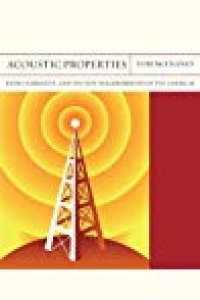
Ebook: Acoustic Properties: Radio, Narrative, and the New Neighborhood of the Americas
Author: Tom McEnaney
- Series: FlashPoints
- Year: 2017
- Publisher: Northwestern University Press
- Edition: Paperback
- Language: English
- pdf
Acoustic Properties: Radio, Narrative, and the New Neighborhood of the Americasdiscovers the prehistory of wireless culture. It examines both the coevolution of radio and the novel in Argentina, Cuba, and the United States from the early 1930s to the late 1960s, and the various populist political climates in which the emerging medium of radio became the chosen means to produce the voice of the people.
Based on original archival research in Buenos Aires, Havana, Paris, and the United States, the book develops a literary media theory that understands sound as a transmedial phenomenon and radio as a transnational medium. Analyzing the construction of new social and political relations in the wake of the United States’ 1930s Good Neighbor Policy,Acoustic Propertieschallenges standard narratives of hemispheric influence through new readings of Richard Wright’s cinematic work in Argentina, Severo Sarduy’s radio plays in France, and novels by John Dos Passos, Manuel Puig, Raymond Chandler, and Carson McCullers. Alongside these writers, the book also explores Che Guevara and Fidel Castro’s Radio Rebelde, FDR’s fireside chats, Félix Caignet’s invention of theradionovelain Cuba, Evita Perón’s populist melodramas in Argentina, Orson Welles’s experimental New Deal radio, Cuban and U.S. “radio wars,” and the 1960s African American activist Robert F. Williams’s proto–black power Radio Free Dixie.
From the doldrums of the Great Depression to the tumult of the Cuban Revolution,Acoustic Propertiesilluminates how novelists in the radio age converted writing into a practice of listening, transforming realism as they struggled to channel and shape popular power.
Based on original archival research in Buenos Aires, Havana, Paris, and the United States, the book develops a literary media theory that understands sound as a transmedial phenomenon and radio as a transnational medium. Analyzing the construction of new social and political relations in the wake of the United States’ 1930s Good Neighbor Policy,Acoustic Propertieschallenges standard narratives of hemispheric influence through new readings of Richard Wright’s cinematic work in Argentina, Severo Sarduy’s radio plays in France, and novels by John Dos Passos, Manuel Puig, Raymond Chandler, and Carson McCullers. Alongside these writers, the book also explores Che Guevara and Fidel Castro’s Radio Rebelde, FDR’s fireside chats, Félix Caignet’s invention of theradionovelain Cuba, Evita Perón’s populist melodramas in Argentina, Orson Welles’s experimental New Deal radio, Cuban and U.S. “radio wars,” and the 1960s African American activist Robert F. Williams’s proto–black power Radio Free Dixie.
From the doldrums of the Great Depression to the tumult of the Cuban Revolution,Acoustic Propertiesilluminates how novelists in the radio age converted writing into a practice of listening, transforming realism as they struggled to channel and shape popular power.
Download the book Acoustic Properties: Radio, Narrative, and the New Neighborhood of the Americas for free or read online
Continue reading on any device:

Last viewed books
Related books
{related-news}
Comments (0)